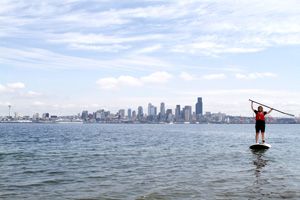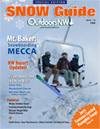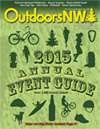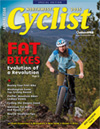SUP: WaSUP? A first-timer’s SUP launch
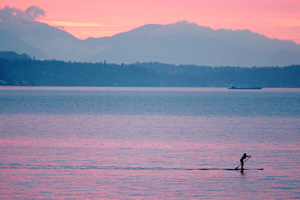
Puget Sound: a cold, salty welcome mat for a ‘flatlander’ from Chicago
By Suzanne Tennant
The Midwest gets a bad rap when it comes to outdoor adventure. Rarely do you see adrenaline junkie articles about white water rafting, extreme climbing, downhill skiing or extreme water sports based in the middle states.
Find one article on the Midwest in any outdoor magazine in a given month, and you’ve stumbled upon gold my friend.
I grew up in Northwest Indiana and lived in Chicago for 17 years and found there are many outdoor opportunities in the Midwest. Besides kayaking on the Chicago River and biking a few parks in the city, you have the Indiana Dunes State Park, Wisconsin’s Apostle Islands and Michigan’s Boyne Mountain — all great places to have an adventure — as long as you can make it out of Chicago traffic and drive two to seven hours to get to them.
For the past 10 years I’ve been longing to move to Seattle where outdoor adventure can be right at your doorstep. I finally took the plunge and moved here three months ago. In between anxiety attacks about how I would support myself, I had anxiety attacks about where I would have my first real Seattle outdoor experience.
I moved to Alki Beach in West Seattle and looked around at the mountains and water while my roommate gave me all of the hiking options I could handle. I stared out the window, eyes glazed over.
I saw a stand up paddle boarder and ran to grab my camera to capture her gliding through the sunset-hued Puget Sound, with the jagged Olympics as a backdrop. This would be my first Seattle adventure! And it was right outside my door, so I went to Alki Kayak Tours and enrolled in its Stand Up Paddle University (SUP-U).
The Lesson
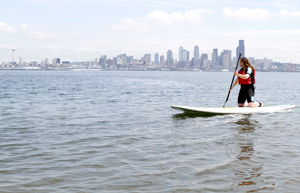
Our intrepid reporter Suzanne Tennant learns the art of SUP’ing off Seattle’s Alki Point. Photos by Shannon Moxley
I had fears about falling. An acquaintance cackled when I asked if wetsuits could make you sink. But I became excited about the possibilities this new sport might provide: a new form of exercise, a new way to experience the water, an introduction to surfing?
When I arrived for my lesson, my instructor Shoshanna geared me up with a wet suit. The information board read, “water temperature today, 43 degrees,” and I imagined falling in: what would that feel like?
Shoshanna explained how different boards were designed to suit different riders. Longer boards go further after each stroke, but are harder to turn; shorter boards are easier to turn, but don’t move as fast.
She gave me the choice between two shorter/wider boards. Like a kid, I chose the board with the cool design. We went to the shore, took our shoes off and felt that 43-degree water. That and the pain of the rocks on my tender citified feet made me hesitate.
Shoshanna started me off in the water with a lesson in oar use and directed me to start by kneeling. I placed my paddle across the center of the board and found my balance. When kneeling, you keep both hands near the center and switch their position when paddling from side to side. When standing, you grab the paddle with one hand at the top and then paddle from side to side without switching positions.
I started to paddle and Shoshanna yelled, “I’ll catch up!” I looked out at the huge ferries and barges and panicked, “catch up?”
She was right behind and gave me some pointers on using the paddle properly, like making sure the scoop part of the paddle is facing away from you and if you need to make a large turn, paddle backward or make a large C with your stroke.
I spotted a ferry that looked like it was headed in our direction. After gliding for a few minutes she asked, “You ready to stand up?”
The wake from one of the boats was coming in. “Uh, let’s wait until this passes,” I replied. Just when I was ready, another wake started to roll in and I yelled, “Wait!”
“Gotta do it sometime,” Shoshanna grinned.
She instructed me to put my paddle down and place it across the center of the board for balance. “One foot at a time, slowly,” she coached.
You have to be fairly good at squatting when going from kneeling to standing and I was glad I had a pretty good squat from doing repeated drills at CrossFit.
I followed Shoshanna’s direction and … was up. I was doing SUP!
Shoshanna gave me some minor tips on standing and paddling — knees slightly bent, arms straight up when pushing down into the water. “Look straight out at the horizon, you’ll feel like you are walking on water,” she said.
It felt transcendental — like I was completely removed from the board and floating toward the sky. We talked about why a lot of people like SUP. You are not as limited by the constraints of an object surrounding you (like the sides of a boat).
“What if I fall?”
But you are also more vulnerable: “What should I do if I fall?” I asked.
“Keep calm and just hold onto it, re-center and kneel,” she said. I told her I almost wanted to do it on purpose to get it over with, then added, “Maybe not. When it’s your time, it’s your time.”
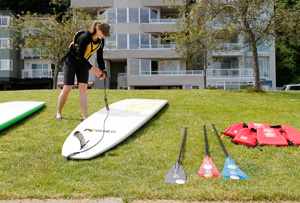
Shannon Moxley, an instructor at Alki Kayak Tours, adjusts the paddle leash during the SUP land lesson. Photo by Suzanne Tennant
Immediately after my comment, I scratched a nagging itchy foot, when the board swayed and bobbed and it was time to be baptized by that chilly water. I struggled one last second and then ran off the front.
My lungs contracted. “Breathe,” I told myself. Despite the pain of the frigid water, there was relief knowing that it was over. I tried to grab my paddle but then lost my grip on the board. Shoshanna yelled, “Forget the oar — you can always paddle to it!” I flopped back on the board like a seal flops onto a rock.
After a few moments of laughter, and relief that the sun was hitting my frozen body, I got back onto my knees, telling Shoshanna, “I want to stay like this for awhile.”
On our way back, a large wake came toward us and Shoshanna instructed me to paddle straight into the wave. As the waves became larger, I became more confident. I even channeled my inner Spicoli from the movie “Fast Times at Ridgemont High” and said, “It’s a way of looking at that wave and saying, ‘Hey Bud, let’s party!’ ”
Then I fell in again.
I climbed back on and as we headed back, Shoshanna explained that men usually lose their balance more often because they have broader shoulders and a higher center of gravity. Then she complimented me on my ability to fall.
We paddled quietly back and as I saw Alki Beach get closer, I couldn’t believe how much less time it took to get back.
“You don’t realize it, but it’s much easier and faster when the wind is at your back,” my instructor told me.
With a soaked head and a happy heart I was glad I didn’t just watch SUP from outside my window. This flatlander was officially welcomed to the Northwest by experiencing the thrills and the trials of SUP and tasting the cold, salty waters of Puget Sound.
Want more info?
http://www.paddlesurfnorthwest.com/

